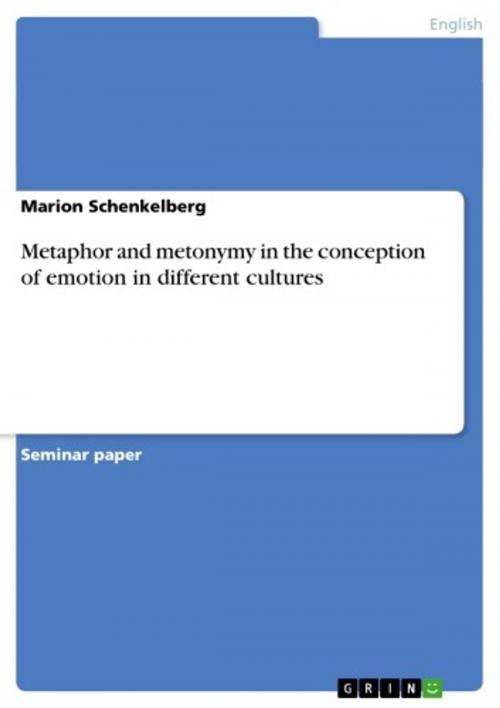Metaphor and metonymy in the conception of emotion in different cultures
Nonfiction, Entertainment, Drama, Anthologies| Author: | Marion Schenkelberg | ISBN: | 9783638289979 |
| Publisher: | GRIN Verlag | Publication: | July 13, 2004 |
| Imprint: | GRIN Verlag | Language: | English |
| Author: | Marion Schenkelberg |
| ISBN: | 9783638289979 |
| Publisher: | GRIN Verlag |
| Publication: | July 13, 2004 |
| Imprint: | GRIN Verlag |
| Language: | English |
Seminar paper from the year 2004 in the subject English Language and Literature Studies - Linguistics, grade: 2+ (B), University of Cologne (Institute for Anglistics), course: Congitive Linguistics, language: English, abstract: Every time we talk about our emotions, we use images, especially metaphors and metonymies. The phenomena of these two kinds of image seem to have always been essential for the human conceptualization of emotions, as Gábor Györi claims: '[...] emotions have always invited the human mind to metaphorise about them' (1998: 117). Thus, the quality of timelessness stresses the importance of this way of reference to emotions. It would be useful to find out if they are also universal regarding culture. If emotions were conceptualized in the same images in cultures that completely differ from each other, there would be an evidence for the universality of metaphors and metonymies in the conceptualization of human emotions. The question of culture-specification includes, additionally to the question if the images in which basic emotions are referred to are universal, also the question whether something like basic emotions exists in general, and is discussed intensively. Except of the meaning of metaphor and metonymy in general and in reference to human emotions, the question of culture-specification will be discussed in this paper. We will have a look at the opponents and supporters of the theory of universality of emotions and emotion images and find out whether they really exclude each other or if one can find a hypothesis that considers both points of view.
Seminar paper from the year 2004 in the subject English Language and Literature Studies - Linguistics, grade: 2+ (B), University of Cologne (Institute for Anglistics), course: Congitive Linguistics, language: English, abstract: Every time we talk about our emotions, we use images, especially metaphors and metonymies. The phenomena of these two kinds of image seem to have always been essential for the human conceptualization of emotions, as Gábor Györi claims: '[...] emotions have always invited the human mind to metaphorise about them' (1998: 117). Thus, the quality of timelessness stresses the importance of this way of reference to emotions. It would be useful to find out if they are also universal regarding culture. If emotions were conceptualized in the same images in cultures that completely differ from each other, there would be an evidence for the universality of metaphors and metonymies in the conceptualization of human emotions. The question of culture-specification includes, additionally to the question if the images in which basic emotions are referred to are universal, also the question whether something like basic emotions exists in general, and is discussed intensively. Except of the meaning of metaphor and metonymy in general and in reference to human emotions, the question of culture-specification will be discussed in this paper. We will have a look at the opponents and supporters of the theory of universality of emotions and emotion images and find out whether they really exclude each other or if one can find a hypothesis that considers both points of view.















